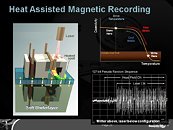Monday, December 3rd 2018

Seagate Achieves Milestone in HAMR HDDs: 16 TB Units Internally Tested
Seagate has been hyping their new HDD density-improvement technology, HAMR, for some time now. The basis of HAMR (Heat-Assisted Magnetic Recording) in Seagate's ypcoiming HDDs is to increase platter density without having to resort to other solutions so as to increase HDD capacity (increased number of platters, increased footprint, etc). The company says that internal tests of 16 TB HAMR-based HDDs are going well, with expected market release to partners by 2019.
HAMR does keep up with compatibility for enterprise customers, being a drop-in upgrade for other HDD-based storage solutions - they're just higher capacity, higher-performance solutions that don't need any special treatment from deployers. The plan is to release 20 TB solutions by 2020, and a staggering 48 TB in the standard 3.5" form-factor by 2024. Seagate further states that HAMR-based drives far exceed industry-required reliability parameters, so the company is bullish on the attention its technology will garner once available to customers in general. The HAMR tech will be deployed firstly on the company's"Seagate has begun running early Exos HAMR units through the full set of standard benchmark tests used to prepare and optimize each new hard drive product for deployment," says Jason Feist, Seagate's senior director of enterprise product line management. "Our testing has demonstrated the drives' compatibility for enterprise systems that are being used today. No system level changes are needed to run the HAMR drives in these evaluations, or to deploy them in customer environments."
Source:
Seagate
HAMR does keep up with compatibility for enterprise customers, being a drop-in upgrade for other HDD-based storage solutions - they're just higher capacity, higher-performance solutions that don't need any special treatment from deployers. The plan is to release 20 TB solutions by 2020, and a staggering 48 TB in the standard 3.5" form-factor by 2024. Seagate further states that HAMR-based drives far exceed industry-required reliability parameters, so the company is bullish on the attention its technology will garner once available to customers in general. The HAMR tech will be deployed firstly on the company's"Seagate has begun running early Exos HAMR units through the full set of standard benchmark tests used to prepare and optimize each new hard drive product for deployment," says Jason Feist, Seagate's senior director of enterprise product line management. "Our testing has demonstrated the drives' compatibility for enterprise systems that are being used today. No system level changes are needed to run the HAMR drives in these evaluations, or to deploy them in customer environments."



23 Comments on Seagate Achieves Milestone in HAMR HDDs: 16 TB Units Internally Tested
:confused:
I know i make that sound simplistic, but we're so far in the consumer side from actual affordable technology capability.
With less energy needed also comes smaller writing coil, so a smaller bit, resulting in more capacity.
Brilliant !
Except, it was really, REALLY tough to get that laser miniaturized enough and precise enough not to damage the material while doing all this, perhaps hundreds of thousands of times in the same spot.
Not a change, at least not in the short term with respect to the release date. Its going to cost "all the money".
Also you can't buy just one 48TB HDD. If it fails it could mean massive data loss. People would likely want to have at least two for RAID 1. Ideal at least four or five for RAID 5 or RAID 6.
Now a much more smarter solution for long-term storage, using SnapRAID to create "Parity Snapshots" on large amounts of data.
What this does is that it doesn't require the entire array to work perfectly to keep your data intact. Each drive is individual, and can even be taken out of the group easily without affecting the functionality of the others (but it still needs to be put back for sync and recovery, as the parity obviously depends on it)
Even more, it's possible to have from 1 to 6!!! levels of parity for monstrous number of drives (40 and up), all protected, up to any size.
UREs not relevant as well, as you would only lose the particular files affected by that dead block, and not the entire disk (or entire array!)
The disadvantage is that it's not real-time, you have to remember to sync regularly (or have a script running every day or so to sync).
It's also not adding the speed benefits of "hardware" RAID5/6, as each drive is still accessed individually - But on the other hand it's also much lower load on the drives, as during syncs only the parity drives get written, while the data drives are untouched. This is very different from normal RAID5/6 where everything is spread on all drives and there's massive Read/Write I/O torturing the drives on every read and write (and especially during recovery !)
~~~
With that said, UREs are not that dangerous today as they used to be before, because all modern drives have sector-level ECC, meaning things have to go REALLY bad in order to completely lose a sector.
Even more, marking bad/recovery is done cleanly by the controller, without blocking the disk on endless attempts to recover a bad sector. It just gets marked as bad, returns an I/O error but then moves on.
Overall, with all the tech that exists today, both hardware, firmware and software, it's very hard to actually lose data when you know what you're doing.
Sorry for the long text. Hope this helps somebody.
Did Samsung realize that they were on the horizon and decided to dump SSDs as fast as possible in the market?